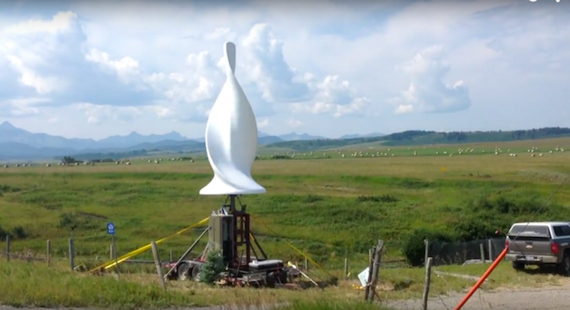I think that wind turbines are ugly. At the same time, I think wind power is the only renewable energy source that can be reliably used to reach the UK's carbon reduction goals.
I'm not alone in saying turbines have a "visual impact." British landscape painters were up in arms against the wind turbines that were covering the UK's hills in 2006.
Their protest echoed a host of other aesthetes, reactionaries, and concerned landowners standing with placards across the country to oppose new wind farms.
Artist Paul Bloomer described his fear of turbines tremendous size, of their spiraling motion, and of "knife-like blades".
He had a nightmare in which he saw turbines invade a countryside abandoned by tourists and children, chopping up birds and exterminating fish.
A wind turbine appears to him like a blender, a meat grinder, or anything else with whirring blades you wouldn't want to mess with.
Descriptions like these are repeated again and again on the placards of anti-wind protesters. Wind turbines are compared to monsters, invaders, or parasites. They are "evil," "industrial," and "hideous." But more to the point, they are "ugly."
Artist Jenny Keal writes, "Vast amounts of concrete poured into our primary water source, huge access roads across previously empty hillsides, new pylons marching across the landscape to say nothing of the hideous machines themselves.
"One is reminded of Tolkien's vision of the destruction of middle earth by the evil forces of greed and lust for power."
Communities appalled by hulking wind turbines are now poised to throw a spanner in the works for good, as the government recently passed a law giving them the final word on new wind farms.
I should be leaping for joy, but at this precise moment, the UK is on course to fail its EU carbon goal for 2020, despite plans hinging on biofuels, and taxpayers will of course be paying the fine.
We will also see more deforestation of land to grow biofuels.
The government has admitted all this in a leaked letter only months after dashing hopes for onshore wind power, the UK's largest non-combustible renewable energy source.
The debate over how tasteful a turbine is misses an opportunity to discuss alternative wind turbine designs (or at least, offshore turbines).
This wide spectrum of alternative wind turbine designs was included as artwork in a recent South London art exhibition at Blue Turtle Oasis.
Prototypes are already up and running for small, unobtrusive "tree-shaped" designs, or even small, aerial-like "dish-shaped" designs.
Designs shaped like a "lens" can be covered with a mesh to prevent bird collisions.
Some artists have tried modifying wind turbines' current appearance ironically.
Others like Andrew Rockby-Thomas are trying to innovate less-imposing designs. He says all you need to do to reduce turbines' visual impact is make them lower to the ground and more solid.

Vertical axis wind turbines (VAWT) like this one don't really cast "shadow flicker". Credit: Andrew Rokeby-Thomas
Vertical Axis Wind Turbines (VAWT), are based on a concept that has been around since the 1970s but have gone out of fashion with the big turbine manufacturers.
This design could well be improved to solve the phenomenon of "shadow flicker", where turbine blades in motion cast long, strobe-like shadows over people's houses.
Ideas like these need to be in demand so they can be developed and take root.
As UK communities are being given more say than ever on whether wind farms go ahead, they may insist on beautiful wind turbine designs.